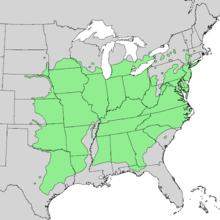Juglans nigra
| Eastern black walnut | |
|---|---|
 |
|
| Leaves and fruit | |
| Scientific classification | |
| Kingdom: | Plantae |
| (unranked): | Angiosperms |
| (unranked): | Eudicots |
| (unranked): | Rosids |
| Order: | Fagales |
| Family: | Juglandaceae |
| Genus: | Juglans |
| Species: | J. nigra |
| Binomial name | |
|
Juglans nigra L. |
|
 |
|
| Natural range | |

Black walnut
|
|
| Nutritional value per 100 grams | |
|---|---|
| Energy | 2,586 kJ (618 kcal) |
|
9.91 g
|
|
| Starch | 0.24 g |
| Sugars | 1.10 g |
| Dietary fiber | 6.8 g |
|
59.00 g
|
|
| Saturated | 3.368 g |
| Monounsaturated | 15.004 g |
| Polyunsaturated | 35.077 g
2.006 g
33.072 g
|
|
24.06 g
|
|
| Vitamins | |
| Vitamin A equiv. |
(0%)
2 μg |
| Vitamin A | 40 IU |
| Thiamine (B1) |
(5%)
0.057 mg |
| Riboflavin (B2) |
(11%)
0.130 mg |
| Niacin (B3) |
(3%)
0.470 mg |
| Pantothenic acid (B5) |
(33%)
1.660 mg |
| Vitamin B6 |
(45%)
0.583 mg |
| Folate (B9) |
(8%)
31 μg |
| Vitamin B12 |
(0%)
0 μg |
| Vitamin C |
(2%)
1.7 mg |
| Vitamin D |
(0%)
0 μg |
| Vitamin D |
(0%)
0 IU |
| Vitamin E |
(12%)
1.80 mg |
| Vitamin K |
(3%)
2.7 μg |
| Minerals | |
| Calcium |
(6%)
61 mg |
| Iron |
(24%)
3.12 mg |
| Magnesium |
(57%)
201 mg |
| Manganese |
(186%)
3.896 mg |
| Phosphorus |
(73%)
513 mg |
| Potassium |
(11%)
523 mg |
| Sodium |
(0%)
2 mg |
| Zinc |
(35%)
3.37 mg |
| Other constituents | |
| Water | 4.56 g |
|
|
| Percentages are roughly approximated using US recommendations for adults. Source: USDA Nutrient Database |
|
Juglans nigra, the eastern black walnut, is a species of deciduous tree in the walnut family, Juglandaceae, native to eastern North America. It grows mostly in riparian zones, from southern Ontario, west to southeast South Dakota, south to Georgia, northern Florida and southwest to central Texas. Wild trees in the upper Ottawa Valley may be an isolated native population or may have derived from planted trees.
Black walnut is an important tree commercially, as the wood is a deep brown color and easily worked. The fruits, walnuts, are cultivated for their distinctive and desirable taste. Often, trees are grown for both lumber and walnuts simultaneously and many cultivars have been developed for improved quality nuts or wood. Black walnut is currently under pressure from the thousand cankers disease which is causing decline of walnuts in some areas. Black walnut is also allelopathic which means that it releases chemicals from roots and other tissues which harm other organisms and give the tree a competitive advantage; this is often undesirable as it can harm garden plants and grasses.
The fruit production tends to occur irregularly with some years producing larger crops than others (see mast year). Fruiting may begin when the tree is 4–6 years old, however large crops take 20 years. Total lifespan of J. nigra is about 130 years. Black walnut does not leaf out until late spring when the soil has warmed and all frost danger is past. Like other trees of the order Fagales, such as oaks, hickories, chestnuts, and birches, it is monoecious, with wind-pollinated catkins. Male and female flowers are in separate spikes, and the female flowers typically appear before the male on a single tree (dichogamy). As a consequence, self-pollination is unlikely. However, individual trees usually are not self-sterile; if they are not pollinated by neighboring trees, they may set self-fertilized seeds. For maximum seed germination, the seeds should be cold-moist stratified for 3–4 months, although the exact time depends on the seed source. The seedlings emerge in April or May and typically grow 90 cm (35 in) their first year and even more in the 2nd year. Black walnut often loses its leaves earlier than other deciduous trees growing in the same area after having a growing period of 115–135 days.
...
Wikipedia
